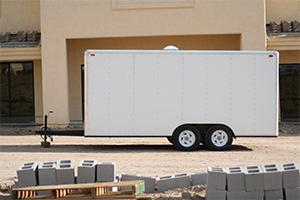Transporting the elderly and special needs passengers
The safety of elderly and special needs individuals while passengers on buses and vans has become a concern. A number of serious accidents have occurred to these individuals while passengers on, as well as while walking to or from, transportation vehicles. Whether you use 15-passenger vans or other types of vehicles, please follow these guidelines designed to help increase the safety of those being transported.
- Ensure that wheelchairs are fastened to the floor with wheelchair brakes locked and passengers strapped into their chairs.
- Check equipment for defects or other maintenance concerns. This includes the wheelchair lift, straps and tracks. Perform these checks pre and post trip.
- When passengers are loading or unloading (whether in wheelchairs or not) always choose a path that is flat, clear of debris and easily accessible. Ensure that the lift is on flat ground to help prevent wheelchairs from tipping.
- Before raising or lowering the wheelchair lift make sure brakes are locked and the gate is secure.
- Ensure that an appropriate number of staff is available to assist before, during and after transport.
- A cell phone or other means of communication should be in the vehicle in case of an emergency.
- Check tire pressure at least once a week. This is extremely important because proper tire pressure lessens the chance of a rollover accident, especially for 15-passenger vans.
- Require all occupants to wear seatbelts.
- If using a 15-passenger van, ensure that passengers as well as cargo are forward of the rear axle, to help reduce the chance of a rollover accident.
- Keep speeds under 50 miles per hour. Always observe posted limits. Be mindful of road conditions. Reduce vehicle speed during bad weather or when traveling on roads that are unfamiliar or hard to navigate.
- Only qualified drivers should be behind the wheel. Special training and experience are required to operate 15-passenger vans so ensure your drivers have both.
Fleet safety program
A fleet safety program is recommended to facilitate the training of drivers who may operate passenger transportation vehicles, including 15-passenger vans. Take a proactive approach to safe driving. Include the following in your fleet safety program:
- Organization’s safe driving policy
- Cell phone use
- Alcohol policy
- Seatbelts
- Driver qualification and record checks
- Driver training
- Include education on the dangers of 15-passenger vans
- Tracking and rewarding safe driving behavior
- Written driver agreements
- Accident reporting
- Vehicle inspection and maintenance programs (including all wheelchair tie-down apparatuses.) All aspects of your fleet safety program should be reviewed annually and updated as needed. Please contact your Hanover Risk Solutions Consultant for assistance.
Copyright ©2014
This material is provided for informational purposes only and does not provide any coverage or guarantee loss prevention. The examples in this material are provided as hypothetical and for illustration purposes only. The Hanover Insurance Company and its affiliates and subsidiaries (“The Hanover”) specifically disclaim any warranty or representation that acceptance of any recommendations contained herein will make any premises, or operation safe or in compliance with any law or regulation. By providing this information to you. The Hanover does not assume (and specifically disclaims) any duty, undertaking or responsibility to you. The decision to accept or implement any recommendation(s) or advice contained in this material must be made by you.
LC JAN 2019 08-291
171-0946 (2/14)
Related resources
Transporting the elderly and special needs passengers
The safety of elderly and special needs individuals while passengers on buses and vans has become a concern. A number of serious accidents have occurred to these individuals while passengers on, as well as while walking to or from, transportation vehicles. Whether you use 15-passenger vans or other types of vehicles, please follow these guidelines designed to help increase the safety of those being transported.
- Ensure that wheelchairs are fastened to the floor with wheelchair brakes locked and passengers strapped into their chairs.
- Check equipment for defects or other maintenance concerns. This includes the wheelchair lift, straps and tracks. Perform these checks pre and post trip.
- When passengers are loading or unloading (whether in wheelchairs or not) always choose a path that is flat, clear of debris and easily accessible. Ensure that the lift is on flat ground to help prevent wheelchairs from tipping.
- Before raising or lowering the wheelchair lift make sure brakes are locked and the gate is secure.
- Ensure that an appropriate number of staff is available to assist before, during and after transport.
- A cell phone or other means of communication should be in the vehicle in case of an emergency.
- Check tire pressure at least once a week. This is extremely important because proper tire pressure lessens the chance of a rollover accident, especially for 15-passenger vans.
- Require all occupants to wear seatbelts.
- If using a 15-passenger van, ensure that passengers as well as cargo are forward of the rear axle, to help reduce the chance of a rollover accident.
- Keep speeds under 50 miles per hour. Always observe posted limits. Be mindful of road conditions. Reduce vehicle speed during bad weather or when traveling on roads that are unfamiliar or hard to navigate.
- Only qualified drivers should be behind the wheel. Special training and experience are required to operate 15-passenger vans so ensure your drivers have both.
Fleet safety program
A fleet safety program is recommended to facilitate the training of drivers who may operate passenger transportation vehicles, including 15-passenger vans. Take a proactive approach to safe driving. Include the following in your fleet safety program:
- Organization’s safe driving policy
- Cell phone use
- Alcohol policy
- Seatbelts
- Driver qualification and record checks
- Driver training
- Include education on the dangers of 15-passenger vans
- Tracking and rewarding safe driving behavior
- Written driver agreements
- Accident reporting
- Vehicle inspection and maintenance programs (including all wheelchair tie-down apparatuses.) All aspects of your fleet safety program should be reviewed annually and updated as needed. Please contact your Hanover Risk Solutions Consultant for assistance.
Copyright ©2014
This material is provided for informational purposes only and does not provide any coverage or guarantee loss prevention. The examples in this material are provided as hypothetical and for illustration purposes only. The Hanover Insurance Company and its affiliates and subsidiaries (“The Hanover”) specifically disclaim any warranty or representation that acceptance of any recommendations contained herein will make any premises, or operation safe or in compliance with any law or regulation. By providing this information to you. The Hanover does not assume (and specifically disclaims) any duty, undertaking or responsibility to you. The decision to accept or implement any recommendation(s) or advice contained in this material must be made by you.
LC JAN 2019 08-291
171-0946 (2/14)
Related resources
Transporting the elderly and special needs passengers
The safety of elderly and special needs individuals while passengers on buses and vans has become a concern. A number of serious accidents have occurred to these individuals while passengers on, as well as while walking to or from, transportation vehicles. Whether you use 15-passenger vans or other types of vehicles, please follow these guidelines designed to help increase the safety of those being transported.
- Ensure that wheelchairs are fastened to the floor with wheelchair brakes locked and passengers strapped into their chairs.
- Check equipment for defects or other maintenance concerns. This includes the wheelchair lift, straps and tracks. Perform these checks pre and post trip.
- When passengers are loading or unloading (whether in wheelchairs or not) always choose a path that is flat, clear of debris and easily accessible. Ensure that the lift is on flat ground to help prevent wheelchairs from tipping.
- Before raising or lowering the wheelchair lift make sure brakes are locked and the gate is secure.
- Ensure that an appropriate number of staff is available to assist before, during and after transport.
- A cell phone or other means of communication should be in the vehicle in case of an emergency.
- Check tire pressure at least once a week. This is extremely important because proper tire pressure lessens the chance of a rollover accident, especially for 15-passenger vans.
- Require all occupants to wear seatbelts.
- If using a 15-passenger van, ensure that passengers as well as cargo are forward of the rear axle, to help reduce the chance of a rollover accident.
- Keep speeds under 50 miles per hour. Always observe posted limits. Be mindful of road conditions. Reduce vehicle speed during bad weather or when traveling on roads that are unfamiliar or hard to navigate.
- Only qualified drivers should be behind the wheel. Special training and experience are required to operate 15-passenger vans so ensure your drivers have both.
Fleet safety program
A fleet safety program is recommended to facilitate the training of drivers who may operate passenger transportation vehicles, including 15-passenger vans. Take a proactive approach to safe driving. Include the following in your fleet safety program:
- Organization’s safe driving policy
- Cell phone use
- Alcohol policy
- Seatbelts
- Driver qualification and record checks
- Driver training
- Include education on the dangers of 15-passenger vans
- Tracking and rewarding safe driving behavior
- Written driver agreements
- Accident reporting
- Vehicle inspection and maintenance programs (including all wheelchair tie-down apparatuses.) All aspects of your fleet safety program should be reviewed annually and updated as needed. Please contact your Hanover Risk Solutions Consultant for assistance.
Copyright ©2014
This material is provided for informational purposes only and does not provide any coverage or guarantee loss prevention. The examples in this material are provided as hypothetical and for illustration purposes only. The Hanover Insurance Company and its affiliates and subsidiaries (“The Hanover”) specifically disclaim any warranty or representation that acceptance of any recommendations contained herein will make any premises, or operation safe or in compliance with any law or regulation. By providing this information to you. The Hanover does not assume (and specifically disclaims) any duty, undertaking or responsibility to you. The decision to accept or implement any recommendation(s) or advice contained in this material must be made by you.
LC JAN 2019 08-291
171-0946 (2/14)
Related resources
Transporting the elderly and special needs passengers
The safety of elderly and special needs individuals while passengers on buses and vans has become a concern. A number of serious accidents have occurred to these individuals while passengers on, as well as while walking to or from, transportation vehicles. Whether you use 15-passenger vans or other types of vehicles, please follow these guidelines designed to help increase the safety of those being transported.
- Ensure that wheelchairs are fastened to the floor with wheelchair brakes locked and passengers strapped into their chairs.
- Check equipment for defects or other maintenance concerns. This includes the wheelchair lift, straps and tracks. Perform these checks pre and post trip.
- When passengers are loading or unloading (whether in wheelchairs or not) always choose a path that is flat, clear of debris and easily accessible. Ensure that the lift is on flat ground to help prevent wheelchairs from tipping.
- Before raising or lowering the wheelchair lift make sure brakes are locked and the gate is secure.
- Ensure that an appropriate number of staff is available to assist before, during and after transport.
- A cell phone or other means of communication should be in the vehicle in case of an emergency.
- Check tire pressure at least once a week. This is extremely important because proper tire pressure lessens the chance of a rollover accident, especially for 15-passenger vans.
- Require all occupants to wear seatbelts.
- If using a 15-passenger van, ensure that passengers as well as cargo are forward of the rear axle, to help reduce the chance of a rollover accident.
- Keep speeds under 50 miles per hour. Always observe posted limits. Be mindful of road conditions. Reduce vehicle speed during bad weather or when traveling on roads that are unfamiliar or hard to navigate.
- Only qualified drivers should be behind the wheel. Special training and experience are required to operate 15-passenger vans so ensure your drivers have both.
Fleet safety program
A fleet safety program is recommended to facilitate the training of drivers who may operate passenger transportation vehicles, including 15-passenger vans. Take a proactive approach to safe driving. Include the following in your fleet safety program:
- Organization’s safe driving policy
- Cell phone use
- Alcohol policy
- Seatbelts
- Driver qualification and record checks
- Driver training
- Include education on the dangers of 15-passenger vans
- Tracking and rewarding safe driving behavior
- Written driver agreements
- Accident reporting
- Vehicle inspection and maintenance programs (including all wheelchair tie-down apparatuses.) All aspects of your fleet safety program should be reviewed annually and updated as needed. Please contact your Hanover Risk Solutions Consultant for assistance.
Copyright ©2014
This material is provided for informational purposes only and does not provide any coverage or guarantee loss prevention. The examples in this material are provided as hypothetical and for illustration purposes only. The Hanover Insurance Company and its affiliates and subsidiaries (“The Hanover”) specifically disclaim any warranty or representation that acceptance of any recommendations contained herein will make any premises, or operation safe or in compliance with any law or regulation. By providing this information to you. The Hanover does not assume (and specifically disclaims) any duty, undertaking or responsibility to you. The decision to accept or implement any recommendation(s) or advice contained in this material must be made by you.
LC JAN 2019 08-291
171-0946 (2/14)





